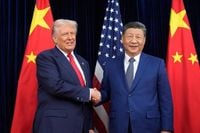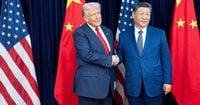In a high-stakes diplomatic dance that played out over two days in South Korea, U.S. President Donald Trump and Chinese President Xi Jinping have agreed to a fragile truce in their long-running trade war. The agreement, reached during a closely watched summit in Busan on October 30, 2025, and publicly addressed by both leaders the following day, offers a temporary reprieve from escalating tariffs and supply chain disruptions, but leaves many fundamental issues unresolved. As the dust settles, economists, business leaders, and politicians on both sides are parsing the details—and the notable lack thereof—amid cautious optimism and lingering uncertainty.
According to The Guardian, the meeting resulted in what can best be described as a ceasefire rather than a comprehensive peace. While both sides have agreed to withdraw some of their most aggressive measures, the truce is set to last only a year, giving each country time to regroup and reassess its strategic priorities. The framework also includes plans for reciprocal visits between the two leaders within the next twelve months, signaling a tentative commitment to broader diplomatic engagement.
The roots of this latest flare-up date back to April 2025, when President Trump reignited the trade war with threats of tariffs as high as 145% on Chinese goods. The U.S. ultimately imposed tariffs averaging 55%, a level that, while short of the most extreme threats, was still high enough to test the resilience of the Chinese economy. China responded in kind, vowing to "fight to the end" and expanding its own export controls, particularly on rare earth elements vital to global high-tech manufacturing.
Yet, as Bloomberg News and Reuters report, the agreement reached in Busan represents a partial rollback of these hostilities. The U.S. will reduce its tariff on fentanyl-related goods from 20% to 10%, contingent upon China’s commitment to curb the export of chemicals used to produce the synthetic opioid. This move brings the overall U.S. tariff rate on Chinese goods down from 57% to approximately 45%, still high by historical standards but a notable step back from the brink. President Trump told reporters, "As soon as we see that, we'll get rid of the other 10%."
For its part, China has agreed to delay new restrictions on the export of rare earth minerals for at least a year, a concession that offers relief to global manufacturers and buyers who have been scrambling to diversify supply chains. China will also resume buying "tremendous amounts" of American soybeans, with state-owned food giant COFCO already purchasing three cargoes ahead of the summit, according to Reuters. The two countries have also agreed to suspend tit-for-tat port fees on each other’s shipping vessels for the next twelve months, further de-escalating trade tensions.
The agreement’s impact on other sectors remains less clear. The U.S. will mediate talks between Beijing and Nvidia’s CEO Jensen Huang regarding the sale of advanced chips to China, but President Trump clarified that the most powerful Blackwell AI chips were not specifically discussed. "We did discuss chips," Trump said aboard Air Force One, "They’re going to be talking to Nvidia and others about taking chips." This ambiguity leaves U.S. technology companies and Chinese buyers in a holding pattern, waiting for further guidance.
Despite the breakthrough, the truce has its critics and skeptics. Many in the U.S. Congress, including members of the president’s own party, have expressed frustration with the lack of clarity and enduring high tariffs. The U.S. Senate recently passed several resolutions aimed at repealing Trump’s country-specific tariffs, and the Supreme Court is set to hear a challenge to the legality of these measures next week. The debate is far from settled, and the potential for renewed conflict looms large.
Internationally, the summit’s ripple effects are being felt in unexpected places. Trump’s abrupt decision to halt trade talks with Canada over a spat involving an ad featuring Ronald Reagan criticizing tariffs led to the threat of a new 10% tariff on Canadian goods. While Trump later described a "nice conversation" with Canadian Prime Minister Mark Carney, the episode underscores the volatility of current trade dynamics. Canada’s central bank governor, Tiff Macklem, warned that "the US trade conflict has diminished Canada’s economic prospects," highlighting the broader collateral damage of U.S. protectionism.
Meanwhile, Japanese Prime Minister Sanae Takaichi, the country’s first female leader, signed new trade and rare earth agreements with the U.S. during the summit, further cementing bilateral ties. Trump praised Takaichi, declaring, "We are an ally at the strongest level," and both leaders touted joint projects in energy, artificial intelligence, and critical minerals. Japan is eyeing investments of up to $400 billion, according to Reuters.
On the economic front, the costs of the trade war have been significant for both sides. U.S. inflation has quietly risen to a politically risky 3%, fueled in part by tariffs, while China’s stock market has surged 34%, defying predictions of a meltdown. China’s trade surplus is likely to surpass last year’s, and the country has successfully redirected exports originally destined for the U.S. to other Asian markets. This adaptability has surprised many American observers and complicated the U.S. strategy of economic pressure.
Both leaders used the summit to reinforce their strategic messages. President Xi warned against "breaking supply chains" during his speech at the Asia-Pacific Economic Cooperation summit in Gyeongju, urging countries to "jointly maintain stable and smooth industrial supply chains." Trump, meanwhile, emphasized provisions in his trade deals designed to protect the U.S. digital economy from discriminatory taxes and regulations, a nod to ongoing concerns about the global reach of American tech giants like Google and Amazon.
Behind the scenes, U.S. Treasury Secretary Scott Besant reportedly played a key role in convincing Trump to pull back from the edge of confrontation, recognizing that the costs of escalation had become unsustainable. "I believe we've reached a very substantial framework that will avoid [a tariff hike] and allow us to discuss that and many other things with the Chinese," Besant said on NBC’s Meet the Press.
Yet, as market analysts and business leaders caution, the devil remains in the details—or, as is often the case with Trump’s agreements, in the lack thereof. Caterpillar CEO Joseph Creed captured the prevailing sentiment among manufacturers when he said, "We really need to have a greater level of predictability and stability in the situation." The constant shifting of duties has made long-term planning nearly impossible for companies caught in the crossfire.
As the world watches, the next year will test whether this truce can evolve into a more durable peace or if it is merely a pause before the next round of economic hostilities. For now, both the U.S. and China appear to be recalibrating, learning from each other’s strengths and vulnerabilities, and preparing for the next phase of their complex and contentious relationship.





